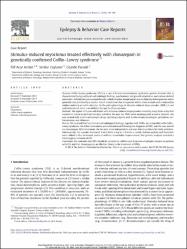| dc.contributor.author | Arslan, Elif Bengi | |
| dc.contributor.author | Ceylaner, Serdar | |
| dc.contributor.author | Turanlı, Güzide | |
| dc.date.accessioned | 10.07.201910:49:13 | |
| dc.date.accessioned | 2019-07-10T19:37:10Z | |
| dc.date.available | 10.07.201910:49:14 | |
| dc.date.available | 2019-07-10T19:37:10Z | |
| dc.date.issued | 2014 | en_US |
| dc.identifier.citation | Arslan, E. B., Ceylaner, S. ve Turanlı, G. (2014). Stimulus-induced myoclonus treated effectively with clonazepam in genetically confirmed Coffin-Lowry syndrome. Epilepsy and Behavior Case Reports, 2, 196-198. https://dx.doi.org/10.1016/j.ebcr.2014.09.007 | en_US |
| dc.identifier.issn | 2213-3232 | |
| dc.identifier.uri | https://dx.doi.org/10.1016/j.ebcr.2014.09.007 | |
| dc.identifier.uri | https://hdl.handle.net/20.500.12511/1347 | |
| dc.description.abstract | Purpose: Coffin-Lowry syndrome (CLS) is a rare X-linked semidominant syndromic genetic disorder that is characterized by typical facial and radiologic findings, psychomotor and growth retardation, and various skeletal anomalies. A distinctive paroxysmal disorder called stimulus-bound myoclonus is clinically heterogeneous and is generally characterized by a sudden loss of muscle tone that is regained within a few seconds and is induced by sudden auditory or tactile stimulus. As the pathophysiology of stimulus-induced drop episodes (SIDEs) is not well understood, there is no definite therapy for those episodes. Methods: We report a 15-year-old female with stimulus-induced drop episodes occurring many times a day that resulted in failure to perform her daily activities. Because her SIDEs were misdiagnosed as atonic seizures, she was treated with several antiepileptic drugs, including valproic acid, levetiracetam, lamotrigine, primidone, carbamazepine, and clobazam. Results: We realized that her clinical and radiological findings, together with SIDEs, are compatible with Coffin-Lowry syndrome. All of her medications were discontinued following the diagnosis of SIDE, and she was started on clonazepam. After treatment, she became more independent and was able to perform her daily activities. Subsequently, her episodes decreased from 3 times a day to 1-2 times a month. Sodium oxybate and fluoxetine were added to the treatment protocol without remarkable improvement. Her genetic analysis revealed a heterozygous variation of CLS. Conclusion: We conclude that SIDE should be included in a differential diagnosis of epileptic seizures in patients with CLS and that clonazepam is an effective choice in the treatment of SIDEs. | en_US |
| dc.language.iso | eng | en_US |
| dc.publisher | Elsevier | en_US |
| dc.rights | info:eu-repo/semantics/openAccess | en_US |
| dc.rights | Attribution-NonCommercial-NoDerivs 3.0 Unported | * |
| dc.rights.uri | https://creativecommons.org/licenses/by-nc-nd/3.0/ | * |
| dc.subject | Clonazepam | en_US |
| dc.subject | Coffin-Lowry Syndrome | en_US |
| dc.subject | Stimulus-Induced Myoclonus | en_US |
| dc.title | Stimulus-induced myoclonus treated effectively with clonazepam in genetically confirmed Coffin-Lowry syndrome | en_US |
| dc.type | article | en_US |
| dc.relation.ispartof | Epilepsy and Behavior Case Reports | en_US |
| dc.department | İstanbul Medipol Üniversitesi, Tıp Fakültesi, Dahili Tıp Bilimleri Bölümü, Çocuk Sağlığı ve Hastalıkları Ana Bilim Dalı | en_US |
| dc.identifier.volume | 2 | en_US |
| dc.identifier.startpage | 196 | en_US |
| dc.identifier.endpage | 198 | en_US |
| dc.relation.publicationcategory | Makale - Uluslararası Hakemli Dergi - Kurum Öğretim Elemanı | en_US |
| dc.identifier.doi | 10.1016/j.ebcr.2014.09.007 | en_US |
| dc.identifier.scopusquality | Q4 | en_US |



















